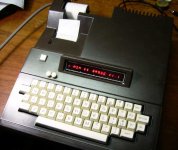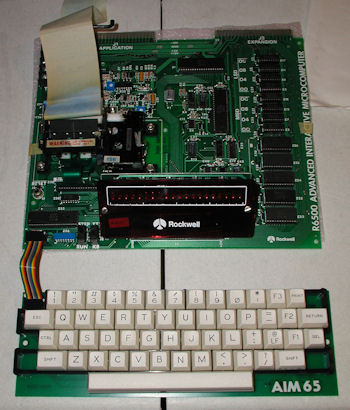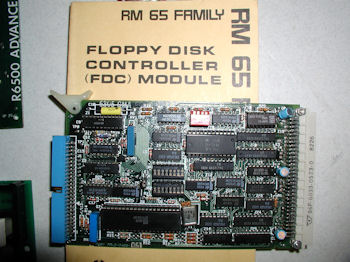Hi MikeS, you are the man!!! Way to go! Now we know we have good code. I've got my 2532s programmed and am configuring my PROM bd to locate at $4000 for my testing. I'm glad to see you have the ComboROM working...did you put BASIC, PL65, Forth, the assembler and the first Pascal ROM on it? Did you mirror the AIM-65 monitor in all banks? I didn't find a reference to it at your link. DaveC
Well, you're the guy who finally inspired me to actually
do something ;-) ; not many other folks are actually actively tinkering with their AIMs, and then your Pascal manual finally made it worth while for me.
The 'ComboROM' only occupies the option area $B000-$CFFF, so the monitor/editor/firmware at $E000-$FFFF and the assembler at $D000-$DFFF aren't affected; AFAIK nothing else ever goes into those areas unlike the $B000-$CFFF area which is where
all the languages reside, one at a time.
It's a 27256 32kB EPROM with 4 blocks of 8kB each containing the 4 different language images and a DIP switch to select one of the 4 8kB sections. It's plugged into the 'B' ROM socket but since that socket only decodes 4kB a jumper to the 'C' chip select on the main board is required for the full 8kB; on the 40kB board that's no problem since it has the 25/2732 jumpers, one of which is /CE, but on the 4K board you'd have to add a header pin, probably into one of the VIAs carrying the 'C' chip select.
Or you could just use two 27128 16kB EPROMs, one in each socket ( B and C) and not worry about any extra adapters or jumpers aside from the 2532>27128 adapters.
The main reason I went to the trouble of combining them into one chip was to leave the 'C' socket open in case I wanted to use it to connect a RAM chip with some modified decoding to map it into low memory to replace/augment RAM; I'm also working on a memory expander for a Radio Shack M100 at the moment which puts 32kB ea. of RAM and ROM in a 28-pin package which just might be adaptable for this to provide either 32kB of RAM or 16kb RAM & 16kB ROM for Pascal in a 4kB machine.
But I'll wait to see how your idea works out, and maybe we can also use Gubbish's PETvet somehow; these projects are all fundamentally pretty similar.
BTW, here's what an AIM65 looks like with the covers on (assuming you have an enclosure of course):


The DIN jack and cable are the added connection for an RS-232 terminal or emulator; 25 lines of 80 columns, ability to save etc. are soooo much nicer...




